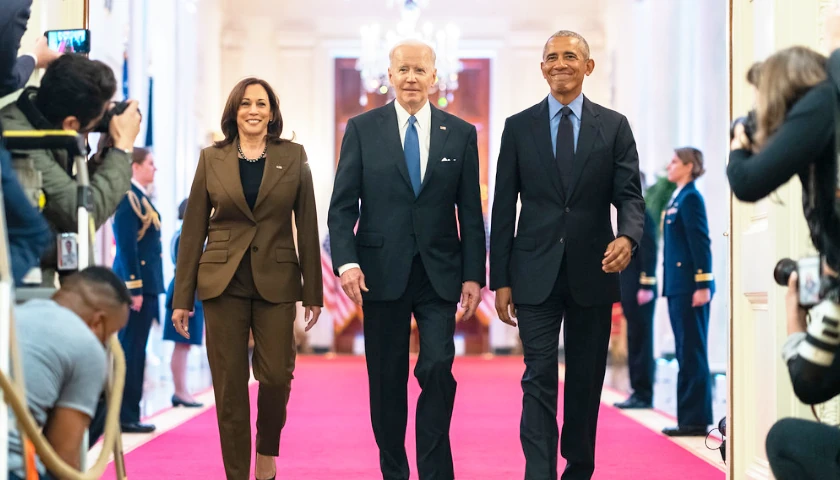by Bethany Blankley
A new proposed rule change to expand railroad regulations without any safety justification “prioritizes politics over sound, data-driven safety policy,” industry experts argue. If implemented, they warn, increased regulatory burdens could drive up shipping costs when consumers already are grappling with 40-year-high inflationary price increases.
The Federal Railroad Administration submitted a notice of proposed rulemaking on crew staffing, reviving an Obama-era effort to require nearly all U.S. freight rail systems to be staffed with two people in the locomotive.
“A minimum requirement of two crewmembers is proposed for all railroad operations, with exceptions proposed for those operations that do not pose significant safety risks to railroad employees, the public, or the environment,” the summary of the 263-page document states. “This proposed rule would also establish minimum requirements for the location of crewmembers on a moving train and promote safe and effective teamwork.”
FRA also proposed “a special approval procedure to allow railroads to petition FRA to continue legacy operations with one-person train crews and allow any railroad to petition FRA for approval to initiate a new train operation with fewer than two crewmembers.”
The proposed rule change was formally published in the Federal Register July 28 and has a 60-day public comment period.
While the FRA argues the changes will create a process to allow modified operations, those in the industry argue it’s creating an unrealistic and arbitrary process that also usurps an already ongoing collective bargaining process.
The proposal “prioritizes politics over sound, data-driven safety policy,” Association of American Railroads President and CEO Ian Jefferies said. “In 2019, the FRA thoroughly reconsidered a rule that was very similar to the one being put forth today and retracted it after finding a complete absence of a safety justification for that rule. We knew then, and we especially know now with the full deployment of Positive Train Control technology, that there is no plausible safety justification for regulating the number of individuals physically located inside the cab of a locomotive.
“As has always been the case, railroad staffing and duty assignment decisions belong at the bargaining table. In fact, this issue is being negotiated right now across the industry in the current round of collective bargaining, and that process should be allowed to conclude without attempted interference in an area never before regulated.”
Those in the industry also point out that the FRA doesn’t include any safety data to justify creating the regulation just as it didn’t when a similar rule change was proposed in 2016.
Since then, railroads have improved their fully functional PTC system, making the regulation even more unjustified, the industry argues. PTC, or Positive Train Control, is a system that combines GPS tracking and an autopilot system to prevent rail collisions and accidents.
While most trains use two-person crews, AAR research has found that a single engineer equipped with PTC is less likely to make mistakes than a two-person crew. Likewise, railroads have become safer as technology has improved, reducing the size of crews needed to operate trains. AAR reports that with less crews, the number of accidents have also declined from roughly 3,000 in 1971 to 400 in 2020.
Clifford Winston, senior fellow at the Brookings Institution, said in a 341-page white paper that the rule change would “weaken an important cost advantage of autonomous rail operations without being based on any evidence that multi-person crews were safer than a single-person crew.”
Robert D. Atkinson with the Information Technology & Innovation Foundation also argues, “As technology such as PTC systems has improved, and further advances in autonomous systems look promising, freight rail companies would like the flexibility of operating trains with less than two operators, not so they can raise profits, but so they can reduce prices to better compete with the trucking sector.”
Existing FRA regulations don’t mandate minimum crew staffing requirements. For Class I railroads, recent industry practice involves having two-person crews (a certified locomotive engineer and a certified conductor) in the locomotive cab for most over-the-road mainline operations.
But non-Class I railroads, including those traveled on by Amtrak, operate with only one person in the locomotive cab. Thousands of Amtrak and commuter passenger trains, carrying hundreds of thousands of passengers, operate every day with only one person in the locomotive cab.
Over the last 15 years, the FRA and other safety regulators have evaluated crew size issues and have yet to find any data showing two-person crews are safer than one-person crews.
In 2009, the FRA said there was “no factual evidence to support [a] prohibition against one-person crew operations.” In 2016, it said it couldn’t “provide reliable or conclusive statistical data to suggest whether one-person crew operations are generally safer or less safe than multiple-person crew operations.” In 2019, it concluded, “Accident/incident data does not support a train crew staffing regulation.”
In 2015, the National Transportation Safety Board (NTSB) found, “There is insufficient data to demonstrate that accidents are avoided by having a second qualified person in the cab. In fact, the NTSB has investigated numerous accidents in which both qualified individuals in a two-person crew made mistakes and failed to avoid an accident.”
– – –
Bethany Blankley is a contributor to The Center Square.





